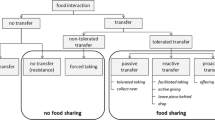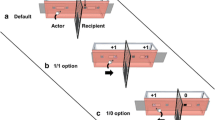Abstract
Handclasp grooming is a unique social custom, known to occur regularly among some, but not all populations of chimpanzees (Pan troglodytes). As with other cultural behaviors, it is assumed that this distinctive grooming posture is learned socially by one individual from another. However, statistical comparisons among factors thought to influence how a behavior spreads within a group have never, to our knowledge, been conducted. In the present study, the origination and spread of handclasp grooming in a group of captive chimpanzees was followed throughout more than 1,500 h of observation over a period of 12 years. We report on the frequency, bout duration, and number and demography of performers throughout the study period, and compare these findings to those reported for wild populations. We predicted that dyads with strong affiliative ties, measured by time spent in proximity to and grooming one another, were likely to develop a handclasp grooming partnership during the study period. A quadratic assignment procedure was used to compare correlations among observed frequencies of grooming and proximity with handclasp grooming in all possible dyads within the group. As predicted, the formation of new handclasp grooming dyads was positively correlated with the rate of overall grooming and proximity within a dyad. In addition, in nearly all dyads formed, at least one individual had been previously observed to handclasp groom. We concluded that affiliation and individual experience determines the transmission of handclasp grooming among captive chimpanzees.




Similar content being viewed by others
References
Boesch C (1996) The emergence of cultures among wild chimpanzees. In: Runciman W, Maynard-Smith J, Dunbar R (eds) Evolution of social behaviour patterns in primates and man. British Academy, London, pp 251–268
Bonnie KE, de Waal FBM (2004) Do rewards and social relationships affect learning of a foraging task in brown capuchin monkeys? Folia Primatol 75(S1):99
Coussi-Korbel S, Fragaszy DM (1995) On the relation between social dynamics and social learning. Anim Behav 50:1441–1453
Dow MM, Cheverud JM (1985) Comparison of distance matrices in studies of population structure and genetic microdifferentiation: quadratic assignment. Am J Phys Anthropol 68:363–373
Dow MM, de Waal FBM (1989) Assignment methods for the analysis of network subgroup interactions. Soc Netw 11:237–255
Dow MM, Cheverud JM, Friedlaender J (1987) Partial correlation of distance matrices in studies of population structure. Am J Phys Anthropol 72:343–357
Hirata S, Watanabe K, Kawai M (2001) Sweet-potato washing revisited. In: Matsuzawa T (ed) Primate origins of human cognition and behavior. Springer, Berlin Heidelberg Tokyo, pp 487–508
Kawai M (1958) On the system of social ranks in a natural troop of Japanese monkey—basic rank and dependent rank. Primates 1:111–130
Kawai M (1965) Newly-acquired pre-cultural behavior of the natural troop of Japanese monkeys on Koshima Islet. Primates 6:1–30
Kawamura S (1958) Matriarchal social ranks in the Minoo-B troop: a study of the rank system of Japanese monkeys. Primates 1:149–156
Kroeber AL (1928) Sub-human culture beginnings. Q Rev Biol 3:325–342
Lonsdorf EV, Eberly LE, Pusey AE (2004) Sex differences in learning in chimpanzees. Nature 428:715–716
Matsuzawa T, Biro D, Humle T, Inoue-Nakamura N, Tonooka R, Yamakoshi G (2001) Emergence of a culture in wild chimpanzees: education by master-apprenticeship. In: Matsuzawa T (ed) Primate origins of human cognition and behavior. Springer, Berlin Heidelberg Tokyo, pp 557–574
McGrew WC (1998) Culture in non-human primates? Annu Rev Anthropol 27:301–328
McGrew WC, Tutin CEG (1978) Evidence for a social custom in wild chimpanzees? Man 13:234–251
McGrew WC, Marchant LF, Scott SE, Tutin CEG (2001) Intergroup differences in a social custom of wild chimpanzees: the grooming hand-clasp of the Mahale mountains. Curr Anthropol 42:148–153
Nakamura M (2002) Grooming hand-clasp in Mahale M group chimpanzees: implications for culture in social behaviors. In: Boesch C, Hohmann G, Marchant LF (eds) Behavioural diversity in chimpanzees and bonobos. Cambridge University Press, Cambridge, pp 71–83
Nakamura M, McGrew WC, Marchant LF, Nishida T (2000) Social scratch: another custom in wild chimpanzees? Primates 41:237–248
Nishida T (1987) Local traditions and cultural transmission. In: Smuts DL, Cheney DL, Seyfarth RM, Wrangham RW, Struhsaker TT (eds) Primate societies. University of Chicago Press, Chicago, pp 462–474
Perry S, Baker M, Fedigan L, Gros-Louis J, Jack K, MacKinnon KC, Manson JH, Panger M, Pyle K, Rose L (2003a) Social conventions in wild white-faced capuchin monkeys: evidence for traditions in a neotropical primate. Curr Anthropol 44:241–268
Perry S, Panger M, Rose LM, Baker M, Gros-Louis J, Jack K, MacKinnon KC, Manson J, Fedigan L, Pyle K (2003b) Traditions in wild white-faced capuchin monkeys. In: Fragaszy DM, Perry S (eds) The biology of traditions. Cambridge University Press, Cambridge, pp 391–425
Sapolsky RM, Share LJ (2004) A pacific culture among wild baboons: its emergence and transmission. PLOS Biol 2:534–541
van Schaik CP (2003) Local traditions in orangutans and chimpanzees: social learning and social tolerance. In: Fragaszy DM, Perry S (eds) The biology of traditions. Cambridge University Press, Cambridge, pp 297–328
van Schaik CP, Ancrenaz M, Borgen G, Galdikas B, Knott CD, Singleton I, Suzuki A, Utami SS, Merrill M (2003) Orangutan cultures and the evolution of material culture. Science 299:102–105
de Waal FBM (1989) Food sharing and reciprocal obligations among chimpanzees. J Hum Evol 18:433–459
de Waal FBM (1990) Do rhesus mothers suggest friends to their offspring? Primates 31:597–600
de Waal FBM (1991) Rank distance as a central feature of rhesus monkey social organization: a sociometric analysis. Anim Behav 41:383–398
de Waal FBM (1994) The chimpanzee’s adaptive potential: a comparison of social life under captive and wild conditions. In: Wrangham RW, McGrew WC, de Waal FBM, Heltne P (eds) Chimpanzee cultures. Harvard University Press, Cambridge, Mass., pp 243–260
de Waal FBM (1996) Macaque social culture: development and perpetuation of affiliative networks. J Comp Psychol 110:147–154
de Waal FBM (2001) The ape and the sushi master. Basic Books, New York
de Waal FBM, Johanowicz DL (1993) Modification of reconciliation behavior through social experience: an experiment with two macaque species. Child Dev 64:897–908
de Waal FBM, Seres M (1997) Propagation of handclasp grooming among captive chimpanzees. Am J Primatol 43:339–346
Whiten A (2001) Primate culture and social learning. Cogn Sci 24:477–508
Whiten A, Ham R (1992) On the nature and evolution of imitation in the animal kingdom: reappraisal of a century of research. Adv Stud Behav 231:239–275
Whiten A, Goodall J, McGrew WC, Nishida T, Reynolds V, Sugiyama Y, Tutin CEG, Wrangham RW, Boesch C (1999) Cultures in chimpanzees. Nature 399:682–685
Acknowledgments
This research was supported by National Institutes of Health (NIH) Grant R01-RR09797, National Institute of Mental Health Grant R03-MH49475, and funding from the Templeton Foundation to the senior author, a National Science Foundation graduate research fellowship to the first author, and NIH Grant RR-00165 to the Yerkes National Primate Research Center. We are grateful to Filippo Aureli, Amy Pollick, Jennifer Rybak, Michael Seres, and Rebecca Singer for help with data collection. We thank Victoria Horner and two anonymous reviewers for comments on an earlier version of the manuscript. We also thank the animal care and veterinary staff at the Yerkes National Primate Research Center for maintaining the health and well being of the chimpanzees. The Center is fully accredited by the American Association for Accreditation of Laboratory Animal Care.
Author information
Authors and Affiliations
Corresponding author
About this article
Cite this article
Bonnie, K.E., de Waal, F.B.M. Affiliation promotes the transmission of a social custom: handclasp grooming among captive chimpanzees. Primates 47, 27–34 (2006). https://doi.org/10.1007/s10329-005-0141-0
Received:
Accepted:
Published:
Issue Date:
DOI: https://doi.org/10.1007/s10329-005-0141-0




